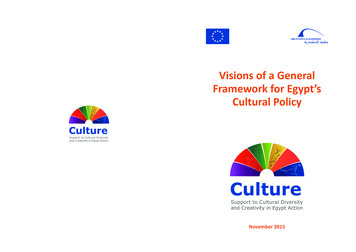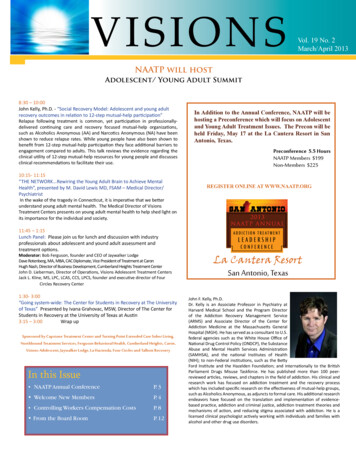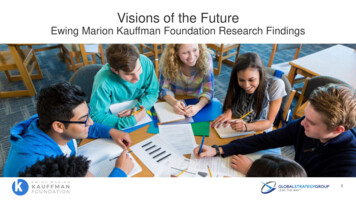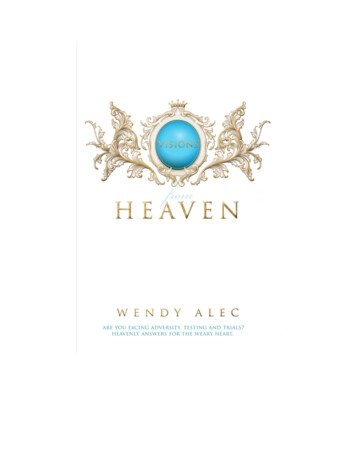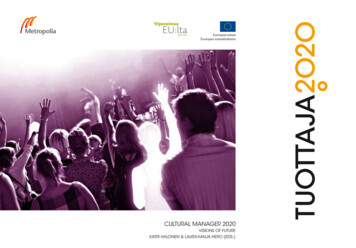
Transcription
CULTURAL MANAGER 2020Visions of FutureKatri Halonen & Laura-Maija Hero (Eds.)
CULTURAL MANAGER 2020Visions of Future1
WRITERSKatri Halonen (Metropolia)Laura-Maija Hero (Metropolia)Outi Teye (Metropolia)Leena Björkqvist (Novia/ Metropolia)Juha Iso-Aho (Humak)Pekka Uotila (MAMK)2
CULTURAL MANAGER 2020. Visions of Future.Katri Halonen & Laura-Maija Hero (Eds.)ISBN 978-952-5797-47-3 (painettu)ISBN 978-952-5797-48-0 (pdf)Metropolia University of Applied Sciences, Culture & Creative Industries, Degree Programme in Cultural Management: Helsinki 2011.Cultural manager 2020 – Partial report 11This study has been conducted as part of Cultural Manager 2020 –project, a Finnish national project partly funded by the European SocialFund (ESF). Cultural Manager 2020 is a joint venture of the FinnishUniversities of Applied Sciences, Humak University of Applied Sciences,Novia University of Applied Sciences, Mikkeli University of Applied Sciences, Foundation for Cultural Policy Research Cupore and the Art andCultural Professionals’ Trade Union TAKU.This work is dedicated to the public domain. You may copy, distribute,display work and make derivative works based on it only if you give theauthors the credits.You can read and copy this text in the internet: http://tuottaja2020.metropolia.fiCover photo: Johanna Tirronen Design: Riikka Käkelä-Rantalainen3
4
Cultural ManagementHeading Towards the Year 2020Will everything change for the future cultural managers in event production? What is the production network like for event producers in 2020?What kinds of challenges do cultural managers face in the future? Whatkind of education do cultural managers need? What are the pedagogicalchallenges in future thinking?Cultural manager 2020 -project predicts the state of event productionnetwork in 2020 and aims to recognize future challenges with respect tocompetence. The highlighted viewpoints consist of both cultural managers’ insights as well as the views of the surrounding professionals. Theproject is carried out by Helsinki Metropolia University of Applied Sciences and is co-financed by the European Social Fund.This report summarizes the conducted work in the project Cultural Manager 2020 during the first two years of the project. It is an evolvingdocument: it was first published in October 2011 and it will be republished in 2012. We hope these articles give you an impulse to proactively search for your own future and also involve your colleagues andstudents in future thinking.Writers (more information p. 45):Katri Halonen (Metropolia), Laura-Maija Hero (Metropolia), Outi Teye(Metropolia), Leena Björkqvist (Novia/ Metropolia), Juha Iso-Aho (Humak), Pekka Uotila (MAMK)Further information:Internet: tuottaja2020.metropolia.fiLaura-Maija Hero (laura-maija.hero@metropolia.fi)5
CONTENTS1. Introduction (Laura-Maija Hero). 72. In Search for Creativity? Finnish Arts Management Education in the European Context (Katri Halonen) . 113. The Changing Networks of Cultural Events (Katri Halonen). 174. Megatrends Shake the Field of Cultural Management (Katri Halonen). 205. Cultural Professionals views on Cultural Management 2020 (Katri Halonen & Outi Teye). 246. Cultural Ecology and Tourism (Pekka Uotila). 277. Volunteers as a Labor Resource and Creators of Community Spirit in Cultural Events (Juha Iso-Aho). 328. Co-Operation and Networks Supporting the Independent Cultural Field (Leena Björkqvist). 369. Future Thinking as a Pedagogical Challenge (Laura-Maija Hero). 40References . 42Writers. 456
Introduction7
1. Introduction“A wind of change is blowing over our societies and reshaping our political, social and cultural paradigms. Increased urbanization, uneven socialredistribution, a digital shift and an array of new audiences accessiblemainly with the use of new technological tools – these are motors ofchange which provide as many challenges as they do opportunities. Canthe education and cultural sector predict these changes so as to position itself at the peak of future developments? In an attempt to forecasttrends and future needs, ENCATC will held its 19th Annual Conference2011 in Helsinki, Finland on October 12–14th 2011.” (www.encatc.org)Laura-Maija HeroThe research process in the Cultural Manager 2020 project aims at developing the national Bachelor’s and Master’s degrees in Cultural Management, as it both defines the skills needed in the future and discusses competency profiles. The research process is carried out in 3years (2009–2012).This report is a collection of English summaries of the reports that arepublished during 2010–2012 in Finnish. There will be a total of 12 bookspublished during this period. You can find all the publications in Finnishon the following Internet page: tuottaja2020.metropolia.fi. We hopethis publication gives you an idea what our project is all about. It is anevolving document: we publish it first in October 2011 mainly for theparticipants of the Encatc Conference in Helsinki, Finland (www.encatc.org). ENCATC is the leading European network on Cultural Managementand Cultural Policy education. It gathers together educational institutions and training organizations dealing with education and training incultural management. Established in Warsaw in 1992, the network includes over 100 members in 35 countries across Europe and beyond.The aim is to give a brief insight into the project targets and goals,change impulses and future visions briefly in English as Encatc sharessome of the projects’ targets:8The articles included in the present report discuss several topics concerning the studies conducted during the research period. First, KatriHalonen, the research manager of Cultural Manager 2020 project, discusses the Finnish Arts Management Education in the European Contextas it is today. It is essential to understand the educational context andcompare Finnish model with British, French and German models. Subsequently, there are research articles written by scholars.In the first phase, the Cultural Manager 2020 project located the eventproduction system and its network models. By interviewing the coreplayers in the field of Finnish cultural production, visions for the eventproduction networks were found. A cultural event forms an intersectionfor a larger ecosystem. Increased professionalism has been detectedthroughout the entire field. Moreover, performance and know-how haveincreased. Generally, the event is structured as an occasional organization with hundreds of players attending an event of few days.After the network analysis, a questionnaire study for the Members ofthe Art and Cultural Professionals’ Trade Union TAKU was sent out andanalyzed. For example, the Utopia, the wanted future, was one whereculture blossoms in rich and diverse art contents in the society as awhole. Therefore, creativity is the key catalyst for development in the
country. Instead of massive multinational monopolies, small subcontractors make the utopia happen. Co-operation with tourism as well as socialand health services is well developed and enriching.At the same time, several researchers studied the volunteer work, tourism, and production network ecology: what are the changing factorsand how will these areas of production evolve in the future? 24 futurescenario workshops were carried out during 2010–11. Several hundredsof Finnish cultural professionals, politicians, other intermediaries anduniversities, more specifically mainly students of cultural management,participated in the vision work. The workshops were conducted by piloting creative methods, such as Storytelling, Digitale, weak signals workshops. These workshops were carefully documented and analyzed, andthe material was used in the projects’ scenario work.One attempt to grasp the future thinking of the field was also to connectthe dilemmas of the field of cultural management to trends and signalsthat seem to be repetitively present in our time. Even though most ofthe signals were collected in the Finnish society, the trends are at leaston some level shared within the Western Europe. Due to McDonaldization and fast internationalization of consumers, the signals are rarelylocal and unique. (Halonen 2011) You can participate in collecting weaksignals in our “signal service” called SignalWiki at tuottaja2020.metropolia.fi. Signals can be uploaded also in English.Another topic in this report is the chasm between culture and tourismexperiences. The future of tourist oriented cultural ecology is dependent on investments in the prerequisites of experience production. Tomake reasonable investments, it is crucial to decide whether the future of events is just one of the many industries that take advantageof nature, or something that treats nature with respect, if nature isconsidered as a strength in the future. Also the educational practicesand project organizations seem to come closer in the cultural ecology.The boundaries between different actors are shifting and the roles ofinstitutions are not that evident as they may have been. The role ofthe cultural manger in a tourist oriented cultural ecology is to makespace for surprising ideas and combine ideas from different actors. Thecultural manager should be able to translate the aesthetic experiencesto new narratives.Also volunteering in the cultural sector stands out in many respects. InFinland, the most common way to volunteer in cultural organizationsconsists of taking part in organizing festivals and cultural events. In thisfield, volunteering is concerned with gathering new experiences, joining people with the similar interests and even getting a free ticket fora couple of hours work, rather than “helping out” or “working for thecause”. The motivations and expectations of future volunteers will probably be more complex and differentiated than today. The crucial thingis to find the forms of volunteering where the needs and aspirations ofthe volunteer in the best possible way meet the needs and objectives ofthe cultural organization. If these can be reconciled with developmentaltasks and the ground rules of the local community and the society inlarger scale volunteering can still be the driving force of event organizingin the next decades.The importance of co-operation and networks in the independent cultural field is studied in this report and the role of the cultural managersas developers of this field is being stressed. The study utilizes the Produforum project and network developed in Finland as a working case. Thechallenge remains in the fragmentation of the development work and,therefore, the proposal is to gather all these operators and set up adevelopment center for cultural know-how. Furthermore, the contentshould be especially directed towards cultural production, thus, creatinga center of excellence in cultural management. In addition to working9
as a center for research and development, it should be connected withagencies providing knowledge and services in the cultural field.Embedding future thinking into the university studies would be very important. The future professionals should have practiced proactive futurework already during the university studies and it should be an integralpart of their competence portfolio. By actively searching for the sharedknowledge concerning the future is of utmost importance also becauseof the consequent risk minimization in the field of culture and for building a strong base for innovation. The future workshops as conductedin the Cultural Manager 2020 project could easily be applied into otherfields, as well. A cultural manager could be the facilitator of the futureworkshops. Moreover, the professional identity of the cultural manageris built on motivating others for their best performance.We hope this report will give rise to questions and ideas to the readerrather than portray a picture of the future. The last research cycle in2012 will be embedding information into the curricula of the FinnishUniversities of Applied Sciences.Cultural Manager 2020 is a joint venture of the Finnish Universities ofApplied Sciences. The degree programmes in cultural management fromthe following institutions act as partners: Humak University of AppliedSciences, Novia University of Applied Sciences, Mikkeli University of Applied Sciences, and Foundation for Cultural Policy Research Cupore. Inaddition, the Art and Cultural Professionals’ Trade Union TAKU acts asthe partner representing work life; Creative Finland Coordination Projectadministered by Aalto University is the partner in charge of communications. The articles in this publication are written by researchers from theabove mentioned universities.Cultural Manager 2020 is a Finnish national project partly funded by the10European Social Fund (ESF). The project is aligned with other projectsadministered by the Finnish National Board of Education, which developthe functioning of the labour markets. European Social Fund supportsproviding education, which meets the needs of work life. Also expeditingthe transition process from the studies to work life is supported. With financial support, the Finnish education system can more efficiently meetthe needs of work life and the demand for labour force.
In Search for Creativity?Finnish Arts ManagementEducation in the European Context11
2. In Search for Creativity? FinnishArts Management Educationin the European ContextKatri HalonenThis article briefly discusses the background and the present situationof the Finnish Cultural management r education provided by universities of applied sciences. Education is facing major challenges as thefield of arts is turning into an increasingly commercial creative industry. In this process, the training centers are forced to reconsider theirrelationship to marketization and cultural values overdriven by managerial efficiency. Simultaneously, the university system in Finland hasbeen developed into a dual-system towards intermediary occupations.One path followed by universities emphasizes academic, science oriented management that focuses on critical thinking and theory basedknowledge. The other path followed by universities of applied sciences stresses practical work-based knowledge, integration of studying and working as well as applying theories into practice rather thantaking part in developing them.Education meets the complex demands rising from society: re-formationof the Nordic post-welfare state system with cultural policy emphasizingthe following aspects: creative economy; commercially driven experience economy; growing number of the elderly cultural consumers; andfinally new technologies and ways of interacting, which grow along with12social media. The present text views Finnish cultural manager trainingfrom the perspective of universities of applied sciences. The followingquestions are posed: how did the education reach this point? What arethe key competences the present education provides for the culturalmanager? How is the dual model of both academic and applied universities been formulated in the training of cultural managers?Background: Cultural Secretaryon the Public SectorThe occupation of cultural secretary gained a legal status, along withmany other occupations in the cultural sector as an extension of theFinnish welfare state regulated in the Cultural Activities Act of 1981.The foundation of the profession was education. Based on the act, theposition of a cultural secretary was regulated to require an universityor college degree. The academic cultural secretaries majored mainly inthe arts and humanities. Since the late 1970s, a college level coursehas been tailored especially for cultural secretaries. As the working environment has changed over the years, the education has changed, andthe differences between educational institutions have been prominent(Halonen 2005 & 2011).The number of cultural mediators amongst European cultural workershas increased during the past decade. At the same time, their influenceon the cultural environment has increased. In Finland, the number ofpositions in the public sector for cultural mediators, especially the positions of cultural secretaries, has decreased following an era of stablegrowth from the 70s until 1993. A change occurred between years 1992and 1999. The stable growth turned into a decline in the number ofoccupations. Between those years, almost 40 per cent of public sectorcultural secretary occupations were terminated.
Along with the changes in society, the educational sector in Finland hasalso changed. In 1997, professional education of cultural secretaries wasterminated at the college level and, in the following years, five universitiesof applied sciences began to offer a Bachelor’s degree in Arts for culturalmanagers. Taking small steps, the training level has improved from vocational to a lower university status, though at the same time, universitieswere giving Master’s Degrees and separate Professional Diploma -programmes in arts.Over time, a new group of trained cultural managershas entered the field of cultural production. However, this group lacks anoccupational reference group relevant to their education.Creative Economy and NewDemands for EducationThe production of culture has become increasingly market orientedover the past two decades. Cuts in government spending are forcingcultural actors to place a greater emphasis on the economic feasibilityand financial independence of their activities. Creativity and innovation(as a unified concept) are common terms in the recent debates aboutthe cultural sector and its role in the future economy and “creativeecologies”. The need to identify creative human capital, the development of new innovative systems and an experience economy areincreasingly discussed.At the university level, the cultural management education in Finlanddeveloped strongly during the 1990s (Halonen 2005, Karhunen 2004).New educational challenges were formulated around arts leadership,production and intermediary processes. Arts management educationhas both American and European roots (Kangas 2002, 256). On onehand, leadership, entrepreneurship and marketing are emphasized andon the other hand cultural policy expertise is focused on. The pioneeringuniversities consist of Jyväskylä University with Cultural Managementtraining and Sibelius Academy with Arts Management diploma, whichstarted in the beginning of 90s. In late 90s, five universities of appliedsciences started providing a 4-year programme in cultural managementemphasizing practical management skills and co-operation with localcultural sector of each educational unit.Finnish higher education employs a dual model, where universities focuson scientific or artistic master’s and advanced degrees and universities of applied sciences mostly offer bachelor’s degrees in vocationaland practical education. The phrase “equal but different” was used inconjunction with the dual model, meaning that Finnish applied scienceuniversities and academic universities serve different goals in the fieldof higher education and should not be combined . The ongoing Bolognaprocess, however, has led to some reformations, where the route tohigher degrees is open as applied science studies with some theoreticalstudies are combined. There is a wide range of cultural managementeducation provided by five polytechnic universities of applied sciences.In addition, a few universities offer temporary master’s degrees partlyfunded by the European social fund. A key factor in education seems tobe managerial and market oriented approach to culture.Bachelor of Arts Education at the FinnishUniversities of Applied SciencesBachelor’s degrees are provided by five universities of Applied Sciencesin Finland. When compared to education of cultural secretaries the present training is more market oriented. The degree consists of a fouryear program with 240 ECTS credits. Most of it is aimed at full-timestudies, but some of is offered part-time for professionals with at leasttwo years of working history at the field of cultural management in in-13
Subject specific competencesDegree programme in culturalmanagement and productionDescription of the competence Competence in cultural operating environment Business competence in cultural productionand management Competence in production processes 14Students are familiar with current trends in culture and arts, as well as their historical background.Students are able to identify and analyse cultural phenomena and their personal relationship with them.Students are able to analyse the field of culture, and to follow it through the media, studies and publicdebates.Students understand and are able to utilise the structures of cultural administration and politics.Students understand the different operating models of the public, third and business sectors, and are ableto outline their future development.Students are able to analyse and develop their professional identity as a cultural producer.Students are familiar with financial planning, budgeting and financial monitoring, and understand thelegislation related to their field.Students are able to seek funding for and implement a cultural product.Students know the basics of marketing and communication from the perspective of cultural productionand management.Students know how to produce a successfulconcept in the creative industries.Students are able to create multiprofessional networks and to organise and lead production processes inthe cultural sector.Students are familiar with the different stages of project organisation, planning and implementation inthe cultural sector.Students are familiar with the legislation related to cultural production and management, and are able toapply their knowledge in production work.Students possess the required communication and media skills in the field.Students master the basics of production engineering and media technology, and are able to apply theirknowledge to production work.Students are able to study and develop different stages of the production process.
termediary positions. Annually about 120–160 new graduates enter thefield from the Finnish universities of applied sciences.Universities of applied sciences have three basic tasks by law. They aimto provide education. They also conduct local research, developmentand innovation (R&D) work. Unlike universities, AMKs focus on R&Dby applying previous knowledge rather than producing new research,on the other hand they have a very clearly legislated objective in theregional development. No tuition fees are collected.The Bachelor’s Degree includes1. core and professional studies of cultural management2. optional studies3. practical training for at least 6 months. In other words,a work placement in addition to a pedagogical project4. Bachelor’s thesis. Basic nature of the thesis is nonacademic in a sense that it proves the abilities of astudent to apply his skills and knowledge into practice.The thesis is often an independent research, productor a development project carried out in work life, e.g.hand book, marketing plan, business plan, a processor a production line. Many students employ themselvesin the organisations in which they conduct their thesis.Master’s educationMaster’s degrees are completed in two different educational surroundings: the universities of applied sciences and the universities. Two universities of applied science provide a joint master’s degree of culturalmanagement. The applicants must have attained a bachelor’s degreeand worked after that for at least three years in cultural intermediarypositions before they are accepted as applicants for the program. Theprogram lasts for a year and consists of part-time studies. The majorfocus is on the master’s thesis, namely a research based developmentprocess conducted for a cultural organisation based on their development needs. Often the thesis is ordered by the employer of the studentand therefore, the thesis is outlined by the employer, student and thetutor of the thesis. The annual intake of students is 20.At academic universities, the students are not required specialisededucation nor work experience in the field of arts management beforeentering the program. However, many of the applicants have both.There are several programs which focus on cultural policy, management and entrepreneurship. Annually about 100 new students areadmitted. The studies last for 2 years and some of the tuition is alsoconducted in English.Academic universities have not made a joint competence table withrespect to the key competences. As they provide academic university15
level education, the emphasis differs from the universities of appliedsciences, e.g. the research competences are more highly valued in theacademic universities.Education in the European contextWhen viewed from the perspective of universities of applied sciences,education for cultural managers is highly practical and production management oriented. Corina Suteau (2006, 150) has produced three different classifications of cultural management training and labelled themas the British, French and German models. In her classification, someof the key words can be seen in the following table:British modelFrench modelGerman modelThe Netherlands, Scandinavian countries, UKSpain, Italy,FranceAustria,Germanymarket values, skillsoriented, labour marketorientedhumanistic values, academic training, weakrelationshipbetweenlabour market andtrainingGreece,Switzerland,balanced mix betweenhumanistic, academicand administrative value oriented educationThe British model seems to be dominant in Finland. The education isstrongly market oriented and it is evaluated according to the statisticswith respect to how well the graduates find their positions from thelabour market after graduation. The training and its results are closelymonitored by the Ministry of Education and Culture and the results ofthis monitoring have a direct influence on the financial base of education. The education is planned and applied to practise with a closeco-operation of labour unions and other professional bodies includingalso individual professionals and organisations from the presumed la-16bour field of the graduates. Also the training includes a close link towork as national and international internships, project based learning inreal production environments and buyer based thesis processes are theeducational norm in the field.A key element in the Finnish arts management training provided by theuniversities of applied sciences is working in the boundaries of the artistic fields. Since labour orientation remains strong in the education, thepresent situation of the art markets pushes the graduates to find a joboften outside the core cultural sector. This happens often in the sphereof commercial event marketing, public and third sector project basedsociocultural work or semi-commercial event production.The development towards market oriented cultural production bringsalong a threat for education losing the core of the cultural management,namely culture. The heart of a cultural manager needs to beat at thesame time with the field of arts rather than business. The process offinding the balance between the different values in the fields of art andbusiness call for creative production solutions. Solutions, those in theend of the day need to be approved by the artists.
The Changing Networksof Cultural Events17
3. The Changing Networks of Cultural EventsKatri HalonenA cultural event is an intersection for a bigger ecosystem: the systeminvolves many companies and other agents. Who are the agents of ecosystem behind the cultural events? How will this ecosystem evolve in thefuture? The amount of cultural events in Finland has increased remarkably during the past 20 years. Cultural events play a critical role whendeveloping the essence of Finnish arts and culture. The cultural eventsalso function as a tool for observing the dynamics of both the cities andsocial life in them. Moreover, they also aim to discover the local mind setand thus they have the power to shape the city. This article examinesevent production from the point of view of its ecosystem.This study is conducted as a case study. There are six cases and sevenresearchers taking part in the process. The cases consist of SavonlinnaOpera Festival, PixelAche, Madonna concert, Kaustinen Folk Music Festival, World Village Festival and Salo Art Museum. The reseachers areKai Artes (Metropolia University of Applied Sciences), Leena Björkqvist(Novia University of Applied Sciences), Katri Halonen (Metropolia University of Applied Sciences), Juha Iso-Aho (HUMAK University of AppliedSciences), Laura Karhu (Cupore), Anu Suosalo (Salo City kaupunki) andPekka Uotila (Mikkeli University of Applied Sciences).Event production networks were rather local. Particularly the contentacquisition was at the same time very international, and partly also the18audience base was international. In the future, there will be more international competitors, especially the growth of virtual services was
tions and training organizations dealing with education and training in cultural management. Established in Warsaw in 1992, the network in-cludes over 100 members in 35 countries across Europe and beyond. The aim is to give a brief insight into the project targets and goals, change impulses and fu



